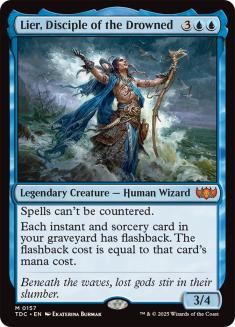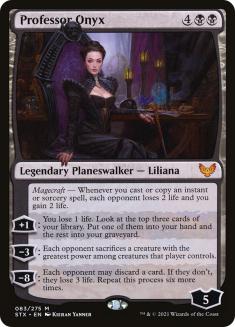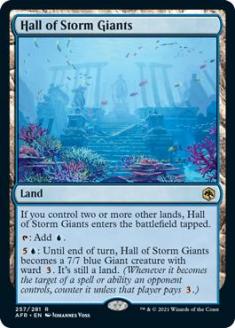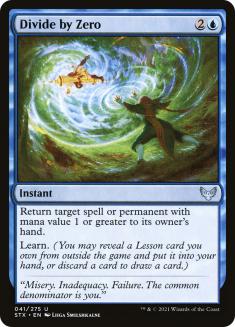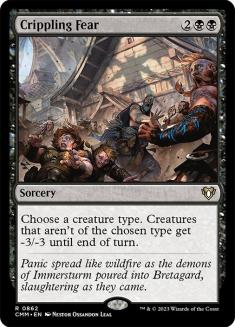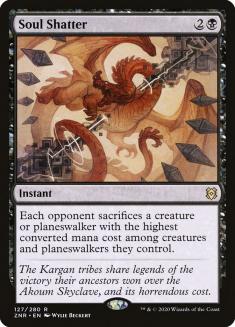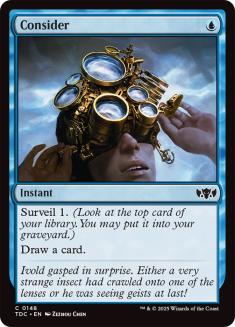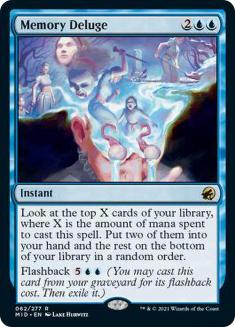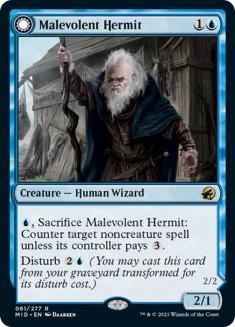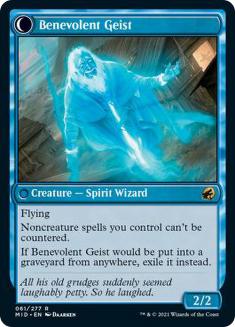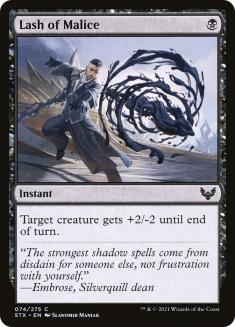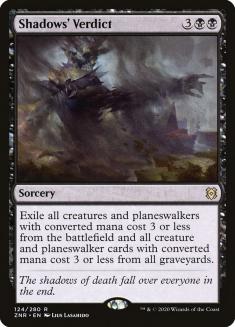The first few days of Innistrad: Midnight Hunt Standard have come and gone, and while we may still be waiting on hard metagame data, I think the rules of engagement are clear.
- Alrund’s Epiphany marks the upper limits of the format and continues to make otherwise appealing options like Golgari Control❄ non-starters.
- The beatdowns are coming primarily from green and Esika’s Chariot, but it’s possible that white-based aggro is figuring out its plans and improving rapidly.
- Floating somewhere in the middle of these two poles (and occasionally staring alongside both of them) is Goldspan Dragon, the best standalone threat in the format.
With these facts seeming indisputable, there’s only one thing to do — play none of these cards.

I get that this seems backwards, but I know the aforementioned stuff is good, and I know it’ll get the lion’s share of attention from the broader Magic community. In the interest of non-duplicative work and with the goal of moving the format forward, it makes far more sense that I spend my time challenging the status quo.
And I come to this column today bearing good news. There’s overlap in both these defining cards and the options to challenge them. It’s possible to outscale Alrund’s Epiphany late-games, sweep the leg of aggressive strategies, and answer Goldspan Dragon at a mana advantage. The key is Dimir Control.
Creatures (7)
Planeswalkers (1)
Lands (23)
Spells (29)

I don’t really know what my deck “brand” is these days, but I was a diehard control mage before modern Magic design did a lot to invalidate that particular play style. I’ve got a lot of success building control decks early in a format, and it usually comes from recognizing when my tools line up to counter the macro-goals of the format. That’s happening right now, and I think a card-by-card breakdown will help illustrate that fact. Let’s look at our baskets of threats, answers, and enablers, as well as one special card that’s filling all three of those spots.
Threats
I’m being generous including Professor Onyx and Hall of Storm Giants in my list of threats. This is a Lier, Disciple of the Drowned deck. When I first saw this card, I wasn’t particularly impressed by it, thinking it might have a role as a quasi-Past in Flames on a big combo turn, but was over-costed for its impact on the game as a fair card.
In a vacuum, this analysis is probably fine, but you get to choose the cards you put into your deck. What if you play plenty of cheap spells that immediately grant you access to multi-spell turns? What if you just include a couple of copies of Malakir Rebirth in your manabase so you can make your Lier unkillable at six mana? Most importantly, what if you found a way to shut off the biggest safety valve on Lier’s rules text? More on this in a moment.
If you untap with Lier in this deck, games feel challenging to lose. It’s why we’re still able to play some countermagic even though Lier theoretically turns it off. If you can protect a Lier, you usually don’t care what your opponent can do. That’s an incredibly powerful statement to make, and not something that even the Wrenn and Sevens, Esika’s Chariots, and Goldspan Dragons of the format can lay claim to. Usually you can race back, or even wade through the sea of mana or card advantage your opponent may gain from these cards. Lier just shuts off potential outs, and it does so by virtue of having an incredible answer in its arsenal.
Answers
Divide by Zero in conjunction with Lier breaks the rules. You have a counterspell, removal spell, and card advantage source in one. Due to the way it’s worded, Divide by Zero can be cast out of your graveyard and “counter” spells on the stack with Lier. When you list the best threats in the current Standard format, the list begins at four mana. With the best threats being so expensive, how are opponents supposed to overcome a recursive Remand that gives you the tools to track down more copies of itself?
The answer is “they can’t.” The combination of Lier and Divide by Zero might be the most frustrating thing you can play against in Standard, and that’s saying a lot in a format that has Alrund’s Epiphany. I’ve moved the size of my Lesson package up and down, but I’m comfortable now with the four different spells I’ve included.
Environmental Sciences is most critical for its lifegain, but this deck certainly doesn’t mind hitting every possible land drop. Confront the Past is a solid out versus all the Wrenn and Seven and Arlinn, the Pack’s Hope around, and can even rebuy a Professor Onyx in a pinch. Introduction to Annihilation is our catch-all, mostly for any opponent that might try to lock us out of our graveyard with something like a Weathered Runestone. And finally, Teaching of the Archaics allows us to dig for more Divide by Zero when we’ve invested much of our hand on getting to a stable Lier-backed battlefield.
Be willing to filter your hand though, especially when you’re in a position where you’re casting your spells from the graveyard anyway. Don’t look at the draw and discard as the worst use of learn — in this deck it’s often the best.
Beyond this, we’re just trying to find to best answers to the threats we expect to see the most of, and the Flunk, Infernal Grasp, Baleful Mastery, and Bloodchief’s Thirst numbers in your deck should be in a constant state of flux. One number that probably should only go up is Soul Shatter. This might be the most important removal spell in Standard right now for its ability to answer Goldspan Dragon at a mana advantage. The punishment you can lay on an Izzet Dragons❄ player who taps out for Goldspan Dragon is massive, and I’ve found that matchup to be extremely favorable in no small part due to Soul Shatter.
As far as sweepers go, we’re mostly choosing between Crippling Fear and Shadows’ Verdict, since The Meathook Massacre doesn’t combine well with Lier. The better option seems to be Crippling Fear right now, since it’s often critical to cast it twice in the same turn to deal with large threats from an opponent. All of these are a little soft versus something like Izzet Dragons❄, and that’s why we do retain the ability to go up to a full four Soul Shatters after sideboarding.
Don’t sleep on the Field of Ruins in this deck either. Creature-lands are a critical part of Standard right now, and Field of Ruin is one of the best reasons to stay with a conservative two-color manabase.
Enablers
Consider is such perfect glue for this version of Dimir Control, fueling your graveyard early and letting you have massive Lier turns late. I wouldn’t consider playing fewer than four. Meanwhile, Memory Deluge is the tool that control decks have been missing for ages. This is what pulls us ahead on cards and finds us what we need in any situation. Again, four is non-negotiable.
The Whole Shebang
It took a few days, but I think I’m no longer making a controversial statement when I declare that Malevolent Hermit is a messed-up Magic card. In this deck, it is both our second-best threat and our second-best answer. Again, we consider the list of important cards in Standard. Alrund’s Epiphany, Esika’s Chariot, Wrenn and Seven… none of these can be cast for less than seven mana while Malevolent Hermit is on the battlefield.
If your opponent does spend removal on Malevolent Hermit, great! That’s one less removal spell they have to answer Lier. Hope they’re ready to play around Benevolent Geist as well, as we happily resolve all our copies of Memory Deluge and Professor Onyx for the rest of the game.
Yes, Malevolent Hermit gets turned off or superseded by Lier once it is on the battlefield. No, I don’t think it matters in the least. Remember, your entire goal is to just untap with Lier. From that point it’ll be smooth sailing. Spend your Hermits early, and you’ll survive to cast Lier. Draw them after you have a Lier on the battlefield, and you don’t care — you’ve got a Lier. Add in the fact that Malevolent Hermit can make two solid blocks in matchups against aggressive decks, brings a respectable amount of pressure against control decks, and also sports an incredibly fashionable hair and beard style (I hope, for my sake) and you have the quiet all-star of this entire strategy.
Sideboarding
Matchups still feel like they are in a state of flux, so I wouldn’t take any of this as a hard rule. Duress is here against Izzet Dragons❄, Control, or any spell-focused combo like Temur Turns or Jeskai Flashback. Against decks with access to increased countermagic counts in sideboard games, this and Malevolent Hermit are how we get to our end-game, and it has the increased upside of absolutely decimating our opponent’s hand from the graveyard once we resolve Lier. I’m extremely close to playing some number of Duress maindeck, and it wouldn’t surprise me if it’s just clearly correct at some point in this metagame since Esika’s Chariot and the planeswalkers are high-value targets out of the aggressive decks.
Lash of Malice is the cheapest and fastest removal spell out there right now, and I like having a couple of copies to help me clean up against hyper-aggressive white-based builds. Against Gruul Aggro or Mono-Green Aggro❄, you must consider their threats carefully before you bring this in. If aggro decks settle upon green as their core color in the format, there’s likely a better option here.
Shadows’ Verdict is fine against those same aggressive green options, even if it doesn’t clean up the very top of their threat range. It answers their very diverse array of tokens, and is a necessary evil, but it has some holes.
I think there should be more Pithing Needles in most nongreen decks right now. As a proactive answer to Wrenn and Seven, it’s extremely mana-efficient. Big bonus points for its ability to shut down all the creature-lands running rampant. If you registered this list with two Pithing Needles and one Lash of Malice because you expected less small aggro, I’d be totally okay with that shift.
Finally, as I mentioned before, I think it’s possible that Soul Shatter is the best removal spell in Standard right now. Spamming copies of it from your graveyard should make it next to impossible for your opponents to find a strong enough foothold to kill you.
In most spots, you’re just looking to move up and down the removal and disruption spectrum after sideboarding. If you want Duress, you probably have some removal to trim. If you want more removal, maybe you’re trimming down Malevolent Hermit and the other countermagic. You don’t need to make huge strategic changes with this setup. As it stands now, your core plan is good against everyone.
Sleeve It Up
In closing, I think Dimir Control is competing for the title of “Best Deck in the Format™” right now, but it’s so exciting because its malleability leads me to believe it’s ready to adapt to whatever the format throws at it. Shift your answers as appropriate and you can present an end-game that can’t really be mitigated without dramatic shifts towards controlling the graveyard. Even when those shifts are made, you can always alter your threat composition and take advantage of the fact that you’ve just got a good, solid control deck to fall back on.
I’m not here to play the obvious best cards in the format. I’m here to make new cards earn that title. Malevolent Hermit; Memory Deluge; and Lier, Disciple of the Drowned are about to stake their claims.


